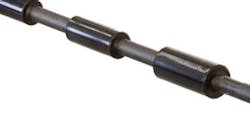Optimizing artificial lift in the Bokor field
Maharon Jadid, Mahmoud Wahba - Petronas Carigali
Dan Saenz - Schlumberger
As production declines and water cut increases, wells are often converted from gas lift to electrical submersible pumps (ESPs). ESPs are an attractive alternative since they can achieve lower bottom-hole flowing pressures, providing opportunities for accelerated production and improved recovery.
A study of the Bokor oilfield, offshore Malaysia, applied a rigorous process to identify three trial wells that likely would benefit from alternative artificial lift technologies to replace or augment existing gas lift systems. ESPs were selected based on their capacity for additional production, reliability, and flexibility to handle the complex reservoirs. ESPs are widely used worldwide, particularly offshore; however, this would be their first application in Malaysia.
Reservoir simulations indicate that the three ESPs, installed mid-2009, will add approximately 2.8 MMbbl incremental oil production over 10 years without significant water cut increase. The conversion also frees lift gas, of which limited supplies are provided from an adjacent field, for use in other wells. A contingency gas lift system mitigates lost production during ESP downtime.
The Bokor field
The Bokor oilfield, operated by Petronas Carigali Sdn Bhd (Petronas), was discovered in the 1970s. It is in the Baram Delta area 45 km (28 miles) offshore Lutong, Sarawak, Malaysia, in water depth of approximately 67 m (220 ft). There are three drilling platforms in the field: BODP-A, BODP-B, and BODP-C.
Field stratigraphy is characterized by stacked sand shale sequences. Oil gravities range from about 20° API in the shallower reservoirs to 37° API in the deeper reservoirs. Throughout its life, as in the majority of the fields in Malaysia, Bokor has produced using gas lift; the supply of lift gas from an adjacent field is declining, and Bokor’s water cut is increasing.
The asset is being redeveloped by the Bokor Project Management Team (BPMT), a gainshare alliance between Petronas and Schlumberger. BPMT is to develop initiatives to improve field performance, and, in 2007, it began a review of artificial lift options. A team was mobilized to identify wells that would benefit most from a change in lift method; select the optimum technology; and provide engineering and project management to implement the changes. Key objectives for the project were to improve economics through enhanced production and reserves recovery, and to enable the reallocation of currently consumed lift gas to other wells.
Selecting candidate wells
A systematic screening process was performed to identify wells that most likely would be to benefit from a change in artificial lift method. The workflow began by considering the characteristics of the different reservoirs of the Bokor field. This identified that gas lift is least effective in the shallow reservoirs, which have relatively higher viscosity oil (10-15 cp), and low gas oil ratio (GOR: 125-150 cu ft/bbl). These shallow reservoirs exhibit productivity indices and reserves that would encourage more aggressive production rates over time.
In the next stage of screening, the team analyzed ways to identify five wells, all producing from the shallow reservoirs, which would be expected to show an increase in production and recovery if bottomhole flowing pressure was reduced significantly. Candidate wells were grouped by platform to ensure that workover resources could be applied efficiently.
The team reviewed subsurface related risks such as uncertainties in geology and fluid contacts. A 2006 update to the field development plan provided 15 different geological realizations. Simulations using all 15 models enabled evaluation of the range in potential upside—and downside—performance for each of the five wells.
The analysis also examined the probable rise in water cut likely to result from increased drawdown, because this could impact recovery rates. The chosen wells were relatively close to the crest of the shallow reservoirs, and the Bokor field has an edge water drive and almost no underlying water, thus limiting the risk of a rise in water cut due to increased drawdown (Dake 1994). Simulations indicated potential for about 5% increase in water cut with increased drawdown, which was not considered a serious risk.
Next, the team considered potential workover risks related to the production history, integrity, and geometry of each well. One of the five potential candidate wells was rejected due to previous severe solids production, as most pumps would not be able to handle substantial solids over time. Another of the wells was rejected as a result of high dogleg severity, a limitation for most pumps. The remaining three candidates, all drilled from the BODP-C platform, showed potential for improving production and recovery and had a manageable risks.
Selecting artificial lift
After selecting three wells that would be likely benefit from an increase in drawdown, the Bokor team investigated which method of artificial lift would be the most economical. Three main options were considered:
- Deepening the depth of gas lift injection
- Installing progressing cavity pumps (PCPs)
- Installing ESPs.
While lowering the point of gas injection would be expected to improve the efficiency of gas lift, low GOR, relatively high viscosities, and the likelihood of increasing water cut make the benefits marginal in the candidate reservoir. Calculations for one well indicated a maximum potential production rate after workover of approximately 2,300 b/d, compared to a current rate of about 2,000 b/d, a gain of 15%.
PCPs generally are considered the most efficient form of artificial lift. PCPs are positive displacement devices that use a steel shaft rotor that turns inside an elastomeric pump body or stator, usually driven by a surface motor. They are suited to lift viscous crude, have higher tolerance to suspended solids than most lift methods, and their low shear design mitigates the formation of emulsions. However, the Bokor wells have doglegs as high as 6°/100 ft; deviations that could render the connecting rod from the surface liable to wear or damage during operation. Another concern was that PCPs deliver relatively low flow rates, and the desired drawdown was at the upper limitations for the technique. In addition, the Bokor team was concerned about the durability of both surface driven PCPs and electrical submersible PCPs (ESPCPs). Offshore interventions are costly, so frequent replacement could make the systems uneconomic.
ESPs are dynamic displacement devices in which the production rate depends upon the pressure head. They can provide a range of flow rates; a series of staged centrifugal sections generate the requisite head at discharge. ESPs use a subsurface motor for operation, so dogleg severity is less concern than for surface driven techniques. In the case of Bokor, the doglegs for both installation and at actual setting are within recommended operating parameters. ESPs have capacity for greater drawdown over other techniques. Simulations indicated that the lowered bottomhole flowing pressure would nearly double current production.
Ultimately, the project team selected ESPs as the form of artificial lift to continue through engineering, based on the capacity for additional production, reliability, and flexibility to handle the fluid properties and complexities of the shallow Bokor reservoirs.
ESP system design
ESPs can be installed within a variety of completion designs. The Bokor team considered three options:
- Standard installation below a retrievable packer
- Conventional configuration with tailpipe for selectivity
- Spooled completion on coiled tubing.
Option 1: The conventional configuration has a standard ESP run below a retrievable packer. This is a simple, economical completion that provides contingency gas lift, allows the use of the existing wellhead, and can be installed in tight dog legs.
However, this configuration provides no selectivity of producing zones, and may require a shroud for sufficient motor cooling in 9 5/8-in. casing.
Option 2: A standard ESP is run above a permanent packer and inline with a Y-tool. The Y-tool splits the flow path between the ESP and the production tubing below, allowing selectivity of producing zones. In operation, the sliding sleeve is opened and the long string from the Y-tool plugged. This allows fluid entry to the side intake of the ESP, which then produces to the surface. If access to the lower completion is desired, the plug in the Y-tool is retrieved via slickline. Additional options allow for production logging through the Y-tool, enabling specific zones to be opened or closed and selectively logged. The configuration also allows for contingency gas lifting, in which case the sliding sleeve is closed via slickline and the short ESP leg of the Y-tool plugged. The additional long string beside the ESP increases fluid velocity and provides improved motor cooling.
Option 3: Deploy the ESP via coil tubing, setting the spooled string inside a packer set above the gravel pack. Tailpipe could be hung below this lower packer to allow selective access to individual zones if the ESP were retrieved. The configuration provides two barriers during workover in the event of pump failure. This option saves the cost of a workover rig – required for options 1 and 2 – but this saving is partially offset by the need for more downhole equipment, including a downhole isolation valve, additional packer, and seal bore assembly. Unless a coil unit is readily available, the configuration provides no contingency lift system if a pump fails.
The project team selected Option 1 based on the philosophy that, since these were to be the first production ESPs in Malaysia, it would be prudent to remain conservative and use proven technology and a straightforward program. A workover plan was prepared to pull the existing dual strings and install the ESP above the uppermost gravel pack packer, leaving the existing gravel pack in place. The upper completion would be replaced with an ESP below a standard completion packer. Malaysian offshore well control legislation requires a packer, thus necessitating a feed-through for an electrical cable. A vent valve is installed in the packer to prevent separated gas from interfering with production. The remainder of the string included a subsurface safety valve, check valve, and sliding sleeve and gas lift mandrels equipped with active gas lift valves above the production packer. This allows mitigation of production loss during a pump shutdown or premature failure. The sliding sleeve allows bypass of the ESP in the event of gas lift production and enables the tubing to be pulled “dry.” It also enables access for stimulating the wells, if required.
Mitigating risk of ESP failure
Replacing ESP systems requires a full well intervention, usually with a workover unit, incurring cost and deferred production. Failures generally come from one of three categories: power supply, well environment, or system design.
Power fluctuations often contribute to ESP failures by stressing the motor and causing undue wear. Bokor satellite platforms, including BODP-C, were powered only by small solar panels, while the BOK-A platform has a 400 kW generator. A subsea power cable was laid from BOK-A to BODP-C to transmit the requisite power. To reduce losses during subsea transmission, a transformer was installed on BOK-A to increase voltage to 6.6 kV. A breaker on BODP-C provides protection in the event of an electrical fault. Beyond the breaker, cabling was run to a step-down distribution transformer, then routed to variable speed drives (VSDs), enabling the project team to vary the frequency of power supplied to the motor – and so control pump speed – to meet the particular requirements of each well.
The surface equipment is housed inside a purpose-designed, air conditioned, pressurized light electrical room (LER) module equipped with safety systems that include gas detection, fire detection/suppression, emergency shutdown, and emergency lighting. The deck of the BODP-C platform was extended to house the LER.
The downhole environment – in particular gas, sand, and emulsions – must be considered when designing ESP systems. Gas can cause locking and increase motor temperature, potentially leading to premature pump failure. Increased drawdown was estimated to result in 20-30% free gas in the system. To mitigate the effects of gas, the pumps are designed with mixed flow stages and incorporate gas separation and handling devices. Additionally, the packers include provision to vent separated gas to the annulus, preventing it from recirculating to the pump intake.
Sand is likely to impact the longevity of an ESP and must be considered in unconsolidated reservoirs. The three Bokor wells intended for workover all have gravel packed completions. Analysis confirmed that the maximum planned drawdown during ESP operations would be within the safety factor for screen collapse. In addition, the ESP string design included such measures as a check valve above the pump to prevent solids fallback during shut-in, bearings of abrasion-resistant zirconium (ARZ) material to protect against wear from smaller particles; and mixed flow stages with a less tortuous flow path.
The shearing action of ESP impellers can create emulsions from oil and water. Emulsions tend to resist flow, leading to increased motor temperatures (Cooper et al 2001). Fluid samples from each of the three wells were separated and then mixed at various water cuts at expected downhole temperature in a Fann viscometer to determine consistency and behavior. These were combined with the shear rate of the pump to calculate apparent viscosities. Based on these calculations, the ESP motors were oversized by approximately 20%, and a shroud was included in the design to increase fluid velocity and to improve cooling.
Overall design of the ESP string was peer reviewed and optimized with the benefit of team experience and accumulated knowledge. As an example, splices were minimized and even eliminated below the packer. Additionally, the team specified a motor design that incorporates the protector and motor into one unit. This allows for oil filling and preparation onshore prior to shipment to the wellsite to reduced the offshore actions required during installation and also to reduce risk of error and to save rig time (ESP system installation times were six to eight hours). Downhole sensors enable ESP performance to be monitored and operational adjustments made in response to conditions.
Final hookup and commissioning was completed in May 2009. By the first week of June 2009, all ESPs were producing. The project, which involved several groups from Petronas and Schlumberger, plus about a dozen third-party contractors, was completed on schedule and was under budget by more than $10 million.
Improved performance
Production increases from the installation of ESPs in the three Bokor wells are predicted to pay-back the workover costs within six months. Reservoir simulations indicate that these ESPs will add approximately 2.8 MMbbl incremental oil production over 10 years without significant water cut increase.
References
Cooper, P., Heald, C. C., Karassik, I. J., Messina, J. P.: Pump Handbook. Third Edition, 2001, McGraw-Hill.
Dake, L.P.: Fundamentals of Reservoir Engineering. Fourteenth Impression, 1994, Elsevier Science, B.V.




